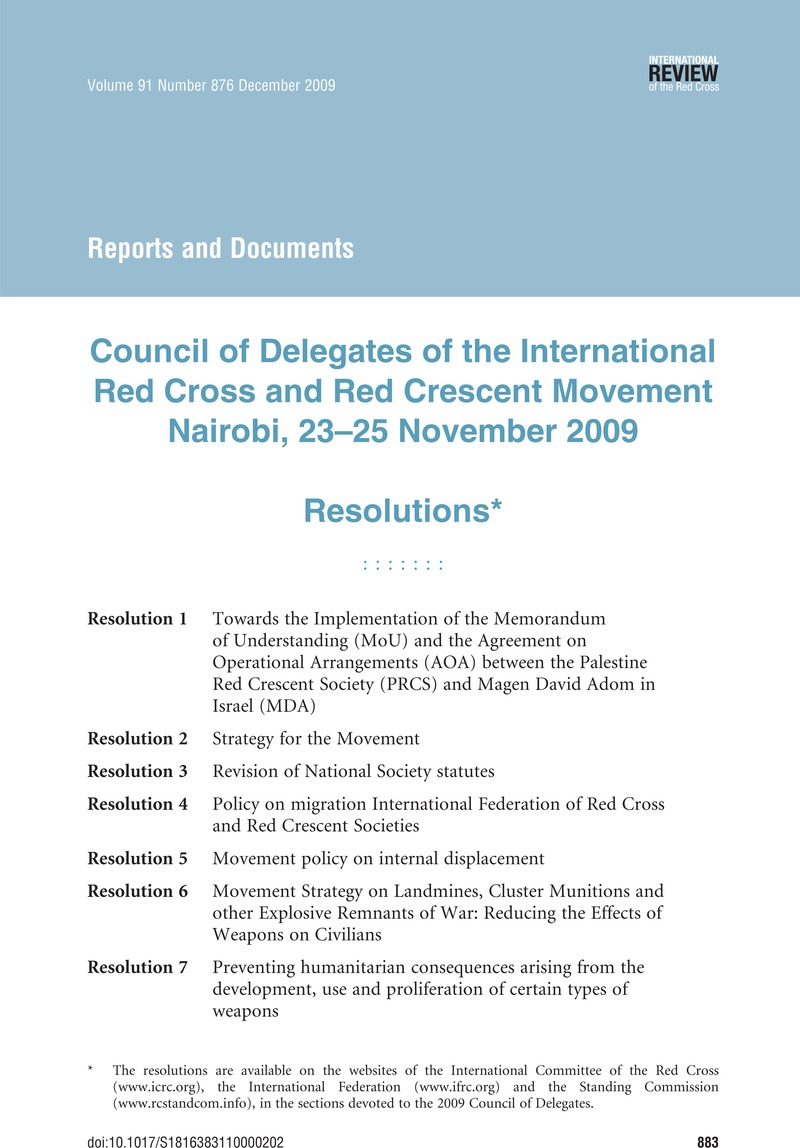No CrossRef data available.
Article contents
Council of Delegates of the International Red Cross and Red Crescent Movement Nairobi, 23–25 November 2009
Resolutions*
Published online by Cambridge University Press: 07 May 2010
Abstract

- Type
- Reports and documents
- Information
- International Review of the Red Cross , Volume 91 , Issue 876: International Conference of the Red Cross and Red Crescent , December 2009 , pp. 883 - 940
- Copyright
- Copyright © International Committee of the Red Cross 2010
References
* The Movement policy on internal displacement has been published in the International Review of the Red Cross, Vol. 91, No. 875, pp. 593–611.
1 The Council of Delegates first began calling for legal and humanitarian action to address the human costs of the use of landmines in 1993 (Resolution 3). By this time, the widespread use of anti-personnel mines in armed conflicts was causing what the ICRC termed an “epidemic” of landmine deaths and injuries. Most casualties were among civilian populations, and most of them occurred after the fighting had ceased. In 1995, the Council called for the Movement to work for a total ban on anti-personnel mines, which, from a humanitarian viewpoint, it considered “the only effective solution” (Resolution 10). During this same period, the ICRC and National Societies began engaging in efforts to prevent casualties, primarily through mine awareness activities and by strengthening their work in physical rehabilitation. The ICRC, many National Societies and the International Campaign to Ban Landmines (ICBL) campaigned publicly for a ban on anti-personnel mines. This led to the signing of the Convention on the Prohibition of Anti-Personnel Mines (Mine Ban Treaty) in Ottawa in December 1997.
2 The Movement's components, and National Societies in particular, discussed their experiences in carrying out such activities at a Movement meeting on weapon contamination held in Siem Reap in Cambodia in January 2009. The National Societies represented at the meeting were from Afghanistan, Angola, Australia, Azerbaijan, Burundi, Cambodia, Colombia, France, India, Iran, Jordan, Laos, Lebanon, Morocco, Nepal, New Zealand, Norway, Tajikistan and Yemen. The discussions at this meeting have informed this new Movement Strategy.
3 In 2003, the 28th International Conference adopted the Agenda for Humanitarian Action. General Objective 2 of the Agenda was to “strengthen the protection of civilians in all situations from the indiscriminate use and effects of weapons and the protection of combatants from unnecessary suffering and prohibited weapons through controls on weapons development, proliferation and use”. Resolution 3 of the 30th International Conference in 2007 reaffirmed “that the right of the parties to an armed conflict to choose methods and means of warfare is not unlimited and that it is prohibited to employ weapons, projectiles and materials and methods of warfare of a nature to cause superfluous injury or unnecessary suffering”. This resolution called on “all States to increase their efforts to strengthen the protection of civilians against the indiscriminate use and effects of weapons and munitions”. It also recognized “the need to urgently address the humanitarian impact of explosive remnants of war and cluster munitions, including through rigorous application of existing rules of international humanitarian law and additional national and international actions that will minimize the harmful effects of these munitions on civilians and on assistance to victims”.
4 Data on incidents, the presence of ERW, mapping of minefields, types of munitions, and so on.
5 Where technical surveys or small-scale clearance are necessary in order for the ICRC to work safely, clearance is generally conducted by accredited clearance operators. Where no accredited operator is available, the ICRC may carry out short-term technical surveys, explosive ordnance disposal, small-scale clearance tasks and marking. This may be the case where the ICRC has sole access to a contaminated area, or in emergency-response situations. The aims are to protect Movement staff, ensure safe access for assistance and protection activities and protect the population.
6 Victims are those who, either individually or collectively, have suffered physical or psychological injury, economic loss or substantial impairment of their fundamental rights through acts or omissions related to the use of weapons. Survivors are persons who have survived a weapon-related accident.
7 As of January 2009, 44 States have ratified the Convention and 26 States have ratified its Optional Protocol.
1 Preamble of the Statutes of the International Red Cross and Red Crescent Movement, adopted by the 25th International Conference of the Red Cross in Geneva in 1986, amended in 1995 and 2006.


